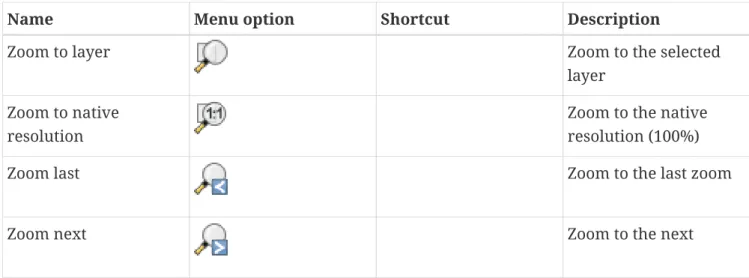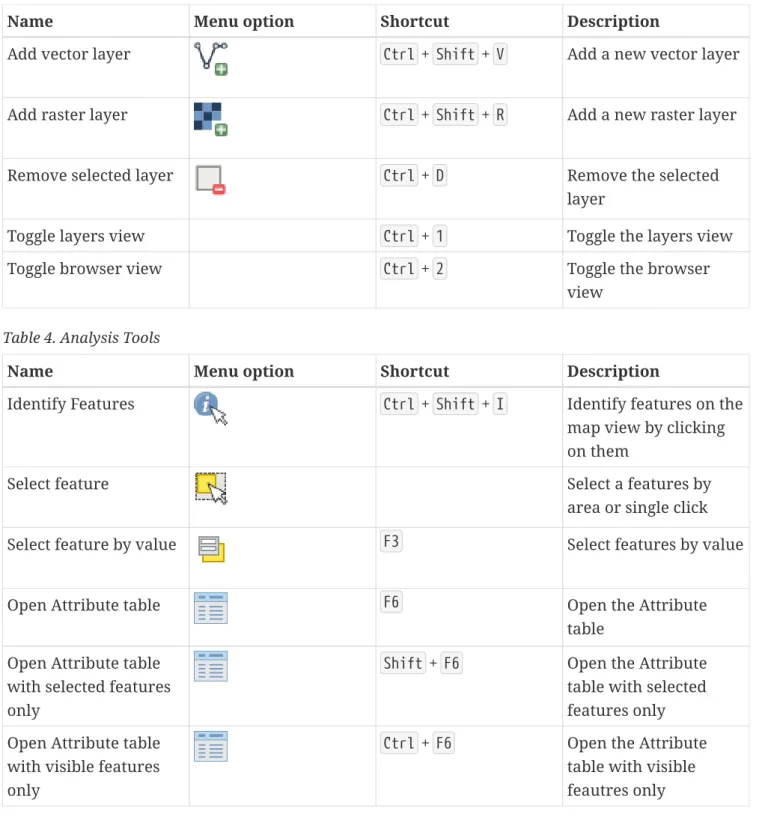QGIS Cheatsheet
GUI Beschreibung
There are more Layers to the GUI of QGIS which arent visible. To open these click on View › Panels.
To open more Toolbars you are able to open them by clicking on View › Toolbars
A different method is to right click on a grey bar in the toolbar area. Now you should be able to see both Panels and Toolbars.
Status bar
From left to right:
1. Coordinate: Show the coordinates your mouse is hovering over in the map window. The coordinates are in reference to the choosen Coordinate Reference System (CRS).
2. Scale: Shows the scale on which the map is visible on the map view. The scale can be changed by either zooming in, zooming out or by selecting one of the predefined options in the dropdown 3. Magnifier: By clicking on the lock you can enable the option to zoom in and out without
altering the scale. The Default value is 100%.
4. Rotation: Can be used to rotate the map clockwise.
5. Rendering: Can be used to disable the rendering of the map temporarily.
6. By clicking on the the dialog for the selection of the Coordinate Reference System opens.
7. By clicking the the log messages show up.
Menu and Toolbar
Navigation in the map view
Table 1. Navigation in the map view
Name Menu option Shortcut Description
Map pan Space, Page Up, Page
Down or the Arrow Keys
Move the map
Pan map to selection Pans the map to the
selected element
Zoom in Ctrl + Alt + + or mouse
wheel
Zoom into the map
Zoom out Ctrl + Alt + - or mouse
wheel
Zoom out of the map
Zoom full Ctrl + Shift + F Zoom out to show the
full map
Zoom to selection Ctrl + J Zoom to the selected
element
Name Menu option Shortcut Description
Zoom to layer Zoom to the selected
layer Zoom to native
resolution
Zoom to the native resolution (100%)
Zoom last Zoom to the last zoom
Zoom next Zoom to the next
Project managment
Table 2. Project managment
Name Menu option Shortcut Description
New Project Ctrl + N Create a new project
Open Project Ctrl + O Open an existing
project Opens the Dialog to create a new print layout
Save Ctrl + S Save the project
Save as… Ctrl + Shift + S Save the project as…
Properties Ctrl + Shift + P Open the project
properties
New print layout Ctrl + P Opens the Dialog to
create a new print layout
Search Ctrl + K Opens the search bar
Layer management
Table 3. Layer management
Name Menu option Shortcut Description
Data source manager Ctrl + L Add a new layer
New GeoPackage layer Ctrl + Shift + N Add a new GeoPackage Layer
Name Menu option Shortcut Description
Add vector layer Ctrl + Shift + V Add a new vector layer
Add raster layer Ctrl + Shift + R Add a new raster layer
Remove selected layer Ctrl + D Remove the selected
layer
Toggle layers view Ctrl + 1 Toggle the layers view
Toggle browser view Ctrl + 2 Toggle the browser
view
Table 4. Analysis Tools
Name Menu option Shortcut Description
Identify Features Ctrl + Shift + I Identify features on the map view by clicking on them
Select feature Select a features by
area or single click
Select feature by value F3 Select features by value
Open Attribute table F6 Open the Attribute
table Open Attribute table
with selected features only
Shift + F6 Open the Attribute table with selected features only Open Attribute table
with visible features only
Ctrl + F6 Open the Attribute table with visible feautres only
Advanced Tools
Table 5. Advanced Tools
Name Menu option Shortcut Description
Processing Toolbox Ctrl + Alt + T Opens the Processing
Toolbox
Python Console Ctrl + Alt + P Opens the Python
Console
For more shortcuts and information read the QGIS documentation
Additional questions? Contact the QGIS community (https://www.qgis.org/de/site/forusers/
support.html)!
Frei verwendbar unter CC0 1.0: http://creativecommons.org/publicdomain/zero/1.0/


